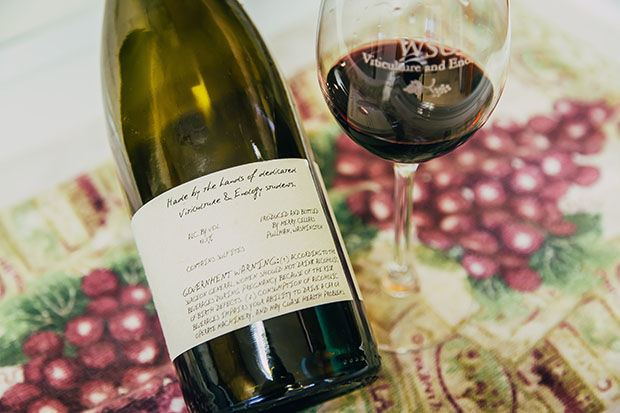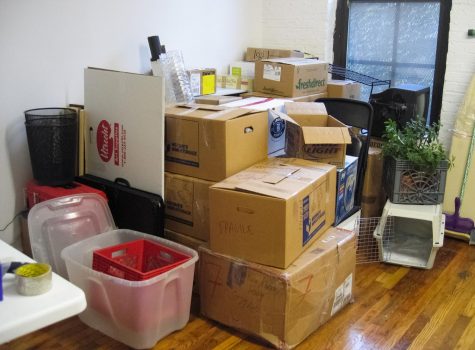Wines in the making
April 22, 2015
Just a few weeks before the harvest was about to begin in fall 2012, a group of viticulture and enology students got together and asked a simple question: Why aren’t we making wine?
As math students do their dark magic, engineers build bridges, and the arts students make … art, it seemed only natural for ones who study the science behind grape growing and wine making should be doing the same.
We ran into one problem early on: Where do we do it?
Very generously, and perhaps foolishly, Merry Cellars Owner Patrick Merry agreed to let us use his facilities and equipment to process our fruit.
Now I say foolishly, because I sure as heck would never entrust my winery to a bunch of kids, especially at the most stressful time (the harvest) for any winemaker.
Now, where do we get the grapes? For the uninitiated, you could go to the supermarket, buy some table grapes, and let that ferment into wine. You could, but you wouldn’t also want to drink it.
Table grapes compared to wine grapes are bred and grown for juice and size. Wine grapes on the other hand require berries that are small and have thicker skins, which is how wine gets its inherent flavor. Table grape wine would be insipid, thin, meek and straight up foul.
To our surprise and delight, the folks at Seven Hills vineyard in Walla Walla and Alder Ridge vineyard in Columbia Valley donated a few tons of fruit to our cause. With location and raw material sorted out, we crushed and processed three tons of Syrah and ½ tons of Viognier that year.
Our 2012 Syrah was co-fermented with 5 percent Viognier. A little bit of the white grape actually helps in making the wine redder, more of a deep purple, through a process called co-pigmentation. It also aids in aromatics with its normally floral nose helping lift the wine.
The inspiration was the Northern Rhone in France where this technique has been used for centuries, a style very different from Washington or Californian wine.
Indeed, compared to many domestic Syrahs in which richness and upfront fruit can be very “bro” like, this is a little more nuanced, with well-integrated acidity, subtle oak influence, but classic Syrah characteristics of smoked meat, green pepper, and cassis.
A wine in flannel among muscle shirts, so to speak.
In 2013, the project continued, this time with Riesling and more Viognier being donated.
The Riesling we released can be seen as a little esoteric. The fruit came in with a small amount of botrytis, a mold also known as “noble rot,” which dehydrates the berries, concentrating the sugars and creating some complex flavors essential in making ice wines like in Canada.
The amount of botrytis, though not heavy, did result in our fermentation getting stuck, hence a somewhat happy “accident” of making an off-dry Riesling.
It is a wild ride of a wine (relative to wine speak) starting off with ripe peaches and nectarines, and an almost honeyed-cream-like component. It transits into a stark austere mid-palette with a bracing acidity in which then sugar tempers the high. Served just slightly chilled, it’s a Riesling that can be taken seriously if need be, but also very quaffable.
Finally our Viognier, a most awkward grape in Washington if I ever saw one. I unfortunately haven’t had any decent domestic Viognier with a tendency for alcohol to be annoyingly high and floral aromatics are often lacking.
Another bit of accidental winemaking, we (i.e. Merry Cellars) ran out of stainless steel tanks so we had to transfer the wine into barrels. Now, this would have been simple if we were going for that style and if the barrels were older, but what resulted was a wine that had lost some of its fruit aroma and was exposed to more oxygen then we would have liked.
Alcohol is noticeable early in the glass, and it does straddle a very thin thread on being immediately overpowering. One sway and you risk Everclear, though it strays thankfully over instead into green apples with weight in the body coming partially from the oak tannins. There’s an acid backbone to keep everything in line. Served cold, it’s a great refresher for the warmer days ahead.
The project continued with last year’s harvest seeing a ton of Merlot donated that is now sitting in barrel, hopefully something that can be released in a couple of years.
In the context of what’s on the shelves, these wines are good, and even if I toot our horns a little bit, very thoughtfully made. A discussion with some industry folk price the whites at $15 and the Syrah for $20 a bottle, sold through Merry Cellars.
By the way, let me make clear that this project is not at all associated with WSU or any organization that may be part of WSU – just a group of students who happened to be studying the same subject collaborating on making wines together.





















